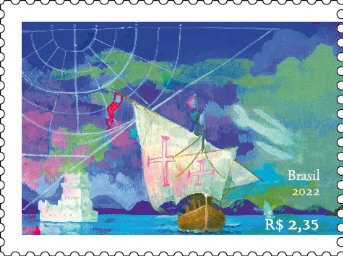Stamp: First Flight Across South Atlantic, Centenary (Brazil 2022)
First Flight Across South Atlantic, Centenary (Brazil 2022)
01 August (Brazil ) within release First Flight Across South Atlantic, Centenary (2022) goes into circulation Stamp First Flight Across South Atlantic, Centenary face value 2.35 Brazilian real
| Stamp First Flight Across South Atlantic, Centenary in catalogues | |
|---|---|
| Colnect codes: | Col: BR 2022.08.01a |
Stamp is horizontal format.
stamp from se-tenant strip of threeAlso in the issue First Flight Across South Atlantic, Centenary (2022):
- Se-tenant - First Flight Across South Atlantic, Centenary face value 3*2.35;
- Full Pane - First Flight Across South Atlantic, Centenary face value 12*2.35;
- Stamp - First Flight Across South Atlantic, Centenary face value 2.35;
- Stamp - First Flight Across South Atlantic, Centenary face value 2.35;
- Stamp - First Flight Across South Atlantic, Centenary face value 2.35;
Stamp First Flight Across South Atlantic, Centenary it reflects the thematic directions:
Aviation is the practical aspect or art of aeronautics, being the design, development, production, operation and use of aircraft, especially heavier than air aircraft. The word aviation was coined by French writer and former naval officer Gabriel La Landelle in 1863, from the verb avier (synonymous flying), itself derived from the Latin word avis ("bird") and the suffix -ation.
A modern sailing ship or sailship is any large wind-powered vessel. Traditionally a sailing ship (or simply ship) is a sailing vessel that carries three or more masts with square sails on each. Large sailing vessels that are not ship-rigged may be more precisely referred to by their sail rig, such as schooner, barque (also spelled "bark"), brig, barkentine, brigantine or sloop. There are many different types of sailing ships, but they all have certain basic things in common. Every sailing ship has a hull, rigging and at least one mast to hold up the sails that use the wind to power the ship. The crew who sail a ship are called sailors or hands. They take turns to take the watch, the active managers of the ship and her performance for a period. Watches are traditionally four hours long. Some sailing ships use traditional ship's bells to tell the time and regulate the watch system, with the bell being rung once for every half hour into the watch and rung eight times at watch end (a four-hour watch). Ocean journeys by sailing ship can take many months, and a common hazard is becoming becalmed because of lack of wind, or being blown off course by severe storms or winds that do not allow progress in the desired direction. A severe storm could lead to shipwreck, and the loss of all hands. Sailing ships are limited in their maximum size compared to ships with heat engines, so economies of scale are also limited. The heaviest sailing ships (limited to those vessels for which sails were the primary means of propulsion) never exceeded 14,000 tons displacement. Sailing ships are therefore also very limited in the supply capacity of their holds, so they have to plan long voyages carefully to include many stops to take on provisions and, in the days before watermakers, fresh water.


